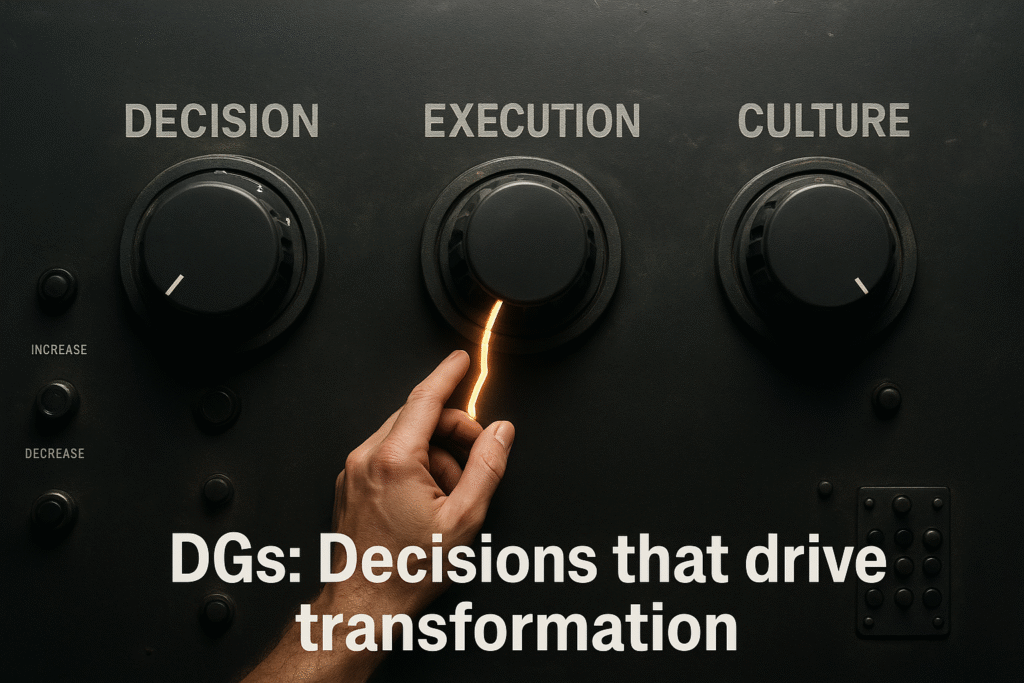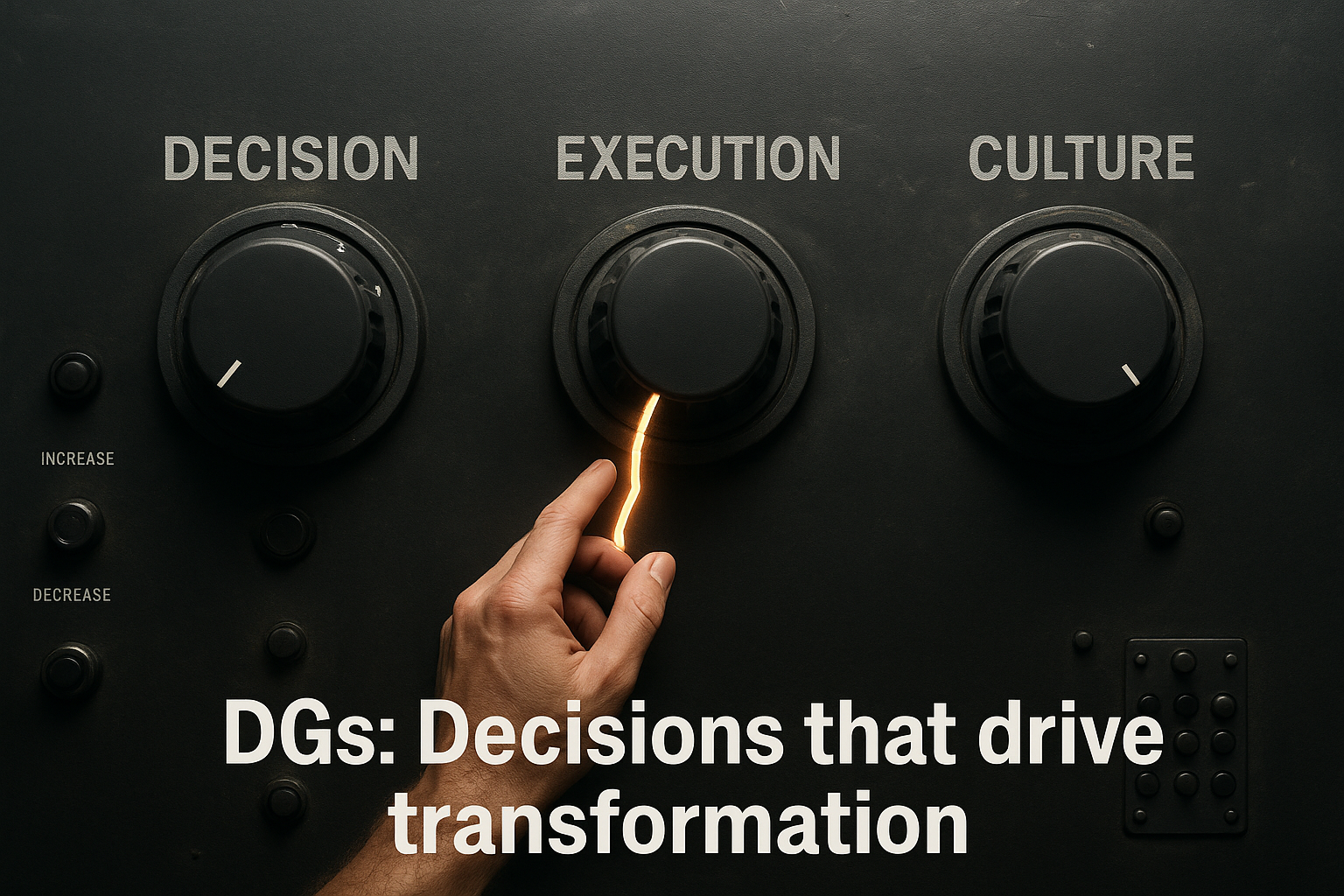DGs at the Operational Helm
Directors General occupy a unique leadership tier in Canada’s federal public service. Situated between ADMs and Directors, DGs are responsible for translating strategic direction into operational reality. Unlike ADMs, who focus on broader portfolios, DGs must make decisions within their own domain and see them through, communicating rationale upward while ensuring compliance, accountability, and cultural alignment.

The DG role is therefore both operational and cultural. You do not merely execute; you shape the norms by which execution occurs. Your decisions signal to staff and subordinates what ownership, accountability, and courage look like in practice.
The DG Mandate: Ownership, Not Just Advice
A recurring challenge for DGs is balancing advisory duties with decision-making responsibilities. Many DGs feel safer escalating complex decisions to ADMs, especially in risk-averse environments. However, research in public administration emphasizes that mid-to-senior leaders like DGs must act decisively within their domains to accelerate organizational transformation (Bourgon, 2011; Aucoin, 2012).
Key responsibilities include:
- Translating ADM strategy into actionable operational plans.
- Making decisions within delegated authority and following through on implementation.
- Communicating clearly with both subordinates and superiors about decisions and their rationale.
- Managing risk while modeling accountability to staff and the wider organization.
The Cultural Dynamics: Navigating Risk-Averse Norms
Federal public service culture encourages risk mitigation. DGs often encounter subtle pressures to defer, escalate, or seek excessive consensus. While these mechanisms ensure compliance and minimize blame, they can impede transformation.
Cultural intelligence is essential. Understanding why teams hesitate, identifying unspoken incentives, and recognizing the structural bottlenecks that encourage deferral allows DGs to act strategically, bridging cultural and operational gaps.
As one DG noted:
“I realized my hesitation was mirrored by my Directors. Only when I took ownership did they start making decisions themselves. Culture follows leadership behavior.”
Operational Decision-Making as Cultural Signal
Every operational decision a DG makes is a signal to the organization. Timely, clear, and accountable decisions:
- Encourage Directors to act confidently.
- Reduce unnecessary escalations.
- Reinforce a culture of ownership and accountability.
Conversely, repeated deferral or excessive consultation signals caution and avoidance. In a risk-averse culture, this cascades quickly, stalling transformation initiatives and limiting the organization’s capacity to innovate.
Independent Insight: Seeing Beyond Routine
DGs operate within the system they are expected to change, making independent insight invaluable. External perspectives can reveal:
- Where decision-making is unnecessarily escalated.
- Where operational bottlenecks are cultural rather than technical.
- How leadership behaviors at DG and Director levels impact organizational performance.
Independent insight equips DGs to act decisively and align operational reality with strategic objectives, ensuring that the culture of accountability is reinforced rather than eroded.
Courage and Decision-Making
Courage is essential for DGs in a transformational environment. This includes:
- Making decisions with incomplete information.
- Acting despite anticipated resistance from peers or subordinates.
- Communicating rationale upward to ADMs and Ministers, demonstrating ownership.
Studies in organizational leadership demonstrate that courageous action at mid-senior levels accelerates transformation, fosters innovation, and strengthens the culture of accountability throughout an organization (Denhardt & Denhardt, 2015; Head, 2018).
Case Example: Operational Transformation
A DG overseeing a multi-branch digital modernization initiative faced persistent delays due to Directors escalating decisions. By asserting authority within their purview, clarifying decision rights, and coaching Directors to take ownership, the DG restored momentum. Within four months, project milestones exceeded projections, illustrating how DG ownership shapes both operational and cultural outcomes.
This example highlights a key principle: DGs are not simply executors of strategy—they are catalysts for cultural transformation, where action, clarity, and accountability cascade downward.
Modeling Accountability: The Ripple Effect
DGs influence both the behaviors of subordinates and the perceptions of superiors. Clear ownership encourages Directors to act decisively and reduces unnecessary escalation to ADMs. When staff witness consistent, accountable decision-making, the organization gradually shifts from risk-averse hesitation to empowered execution.
Public administration research confirms that cascading accountability is a critical lever for change: leaders who model desired behavior at mid-senior levels produce measurable improvements in organizational performance (Bourgon, 2011; Lodge & Gill, 2011).
Decision as a Cultural Act
Every DG decision is both operational and symbolic. Decisions are not neutral; they communicate expectations, signal tolerance for risk, and demonstrate the culture of accountability. DGs who embrace decision-making ownership:
- Reinforce a culture where taking responsibility is expected.
- Provide clarity for Directors, enabling timely action.
- Empower teams to execute strategy effectively.
In essence, the DG role is where strategy meets culture in operational practice. Decisive DGs bridge these two dimensions, accelerating transformation while cultivating accountability.
Conclusion: DGs as Operational Catalysts
Directors General are central to public service transformation. Your ability to make decisions, act on them, and communicate ownership is a critical determinant of organizational performance. By modeling accountability, exercising courage, and leveraging cultural intelligence, DGs ensure that strategy translates into actionable, measurable outcomes.
Transformation requires DGs who are willing to act decisively, lead by example, and influence culture as much as operations. The power to accelerate change lies in your hands—through every decision, every communication, and every action.
What’s Next?
Institute X provides independent insight to help DGs navigate complex operational environments, model accountability, and drive cultural and strategic transformation across the public service.
References
- Aucoin, P. (2012). Democratizing the Constitution: Reforming Responsible Government. Emond Montgomery.
- Bourgon, J. (2011). A New Synthesis of Public Administration: Serving in the 21st Century. McGill-Queen’s University Press.
- Denhardt, J. V., & Denhardt, R. B. (2015). The New Public Service: Serving, Not Steering. Routledge.
- Head, B. (2018). “Wicked Problems in Public Policy.” Public Policy and Administration, 33(3), 257–277.
- Lodge, M., & Gill, D. (2011). “Toward a New Era of Administrative Reform? The Myth of Post-NPM in New Zealand.” Governance, 24(1), 141–166.
- OECD (2020). Leadership for a High-Performing Civil Service. OECD Publishing.

